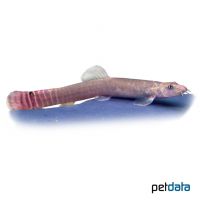Red Tailed Squirrel Loach (Aborichthys elongatus)
| Red Tailed Squirrel Loach Aborichthys elongatus | |
|---|---|
| Name | Red Tailed Squirrel Loach |
| Name Lat. | Aborichthys elongatus |
| Synonym | Noemacheilus elongatus |
| Family | Stone Loaches |
| Family lat. | Nemacheilidae |
| Order | Carps |
| Order lat. | Cypriniformes |
| Origin | NE-India |
| Habitat | Mountain streams |
| Diet | Omnivore |
| pH | 6.0-7.5 |
| Behavior | Peaceful |
| Keeping | Individual, group |
| Care Level | Moderate |
| Reproduction | Oviparous |
| Breeding | None reported |
| Life Span | 5-8 years |
| Protection | No |
| Metric Units | |
| Size | 7 cm |
| Temperature | 20-24 °C |
| Hardness | 5-10 °dH |
| Aquarium | ~ 100 l |
| US Units | |
| Size | 2.8" |
| Temperature | 68-75 °F |
| Hardness | 89-178 ppm |
| Aquarium | ~ 25 gal |
Distribution and habitat
The distribution area of the red-tailed loach is Darjeeling in West Bengal (India). They live in shallow, fast-flowing, oxygen-rich mountain streams and river headwaters, among rocks, boulders and round river pebbles with algae growth.
Maintenance
The aquarium should have a robust planting, with many hiding places (roots, stones, caves). They are very eager to dig and need a fine-grained substrate (sand, round gravel) as well as oxygen-rich water and a strong current.
No ammonia, ammonium and nitrite should be detectable, the nitrate value should not exceed 100 mg/l. To ensure the water quality and oxygen content, a filter and heater adapted to the aquarium size is required, as well as lighting for the species-appropriate day-night rhythm of the animals.
Diet
They feed mainly on insects, small crustaceans and microplankton. The food supply consists of live, frozen and dry food. For a balanced diet, feed once a day with a high-quality sinking dry food (granules, pellets, food tablets) as well as cyclops, daphnia, artemia, mosquito larvae and plankton (live or frozen)
It is recommended to feed small portions several times a day. Only feed as much as will be eaten within a few minutes. A regular and varied diet promotes health and prevents deficiency symptoms.
Behaviour and compatibility
They are sociable fish, whereby it comes within the group more often to quarrels. Socialization is only recommended with robust, not too small fish. At least 5 red-tailed loaches should be kept together.
Basically, only compatible fish species with similar demands on water condition and water temperature may be socialized.
Sex dimorphism
The females are larger and more plump than the males.
Reproduction and breeding
There are no known reports of successful breeding in the aquarium.
Important
The decoration in the aquarium must be built very stable, because they can dig tunnels and caves under the stones and roots, causing them to collapse.
The well-being of the fish must be checked regularly. The temperature should be checked daily, the pH, hardness and nitrate value at least every 14 days. Regular partial water changes are recommended, even if the contaminant level has not yet reached the upper limit. Sudden changes in water quality should be avoided. Newly introduced fish must be accustomed slowly to the water in the aquarium.
Further literature can be found in your pet store.
References
Text: petdata; Image: petdata
Source: BMELV (1998): Tierschutzgutachten - Haltung von Zierfischen (Süßwasser); BAENSCH & RIEHL (2004): Aquarien Atlas Bd. 2, Mergus Verlag; ENGELMANN (2005): Zootierhaltung - Tiere in menschlicher Obhut: Fische, Verlag Harri Deutsch
- Gemäß § 21 Abs. 5 Tierschutzgesetz idgF
